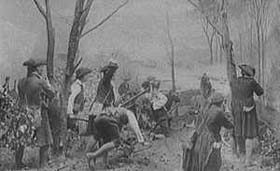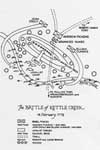Colonial Wars |
American Wars |
Link To This Page — Contact Us —
The Battle of Kettle Creek
Febuary 14, 1779 at Kettle Creek, Georgia
 |
|||||||||||||||||||||
|
The backwoods of Georgia held many challenges for the British Army. Many of the people in Georgia were strongly anti-British.
On February 11, 100 Patriots attack them while crossing Van(n)'s Creek in spite of being outnumbered by the British force..
On February 14, when Col. James Boyd and 700 British loyalists set up camp along Kettle Creek, they knew to be prepared for an attack. Things were not going well for the Loyalists. Boyd is expecting additional men to assist in a strike against the Patriots. His men are not regulars and dissention fills the ranks. And the skirmish at Vann's Creek alert Cols. John Dooly and Andrew Pickens to the Loyalist's presence in Wilkes County. As was the custom, the Loyalist send scavengers out to find food.
That morning, about 150 men were out searching for food when Pickens attacked. With a combined total of 340 men, the Patriots attacked in 3 columns, Col. Dooly on the right, Pickens in the middle, and Lt. Col. Elijah Clark, Dooly's second in command, on the left. A small advance guard was sent in front of the columns to scout the British. Col. Pickens scouts were surprised by Boyd's Loyalist sentries and opened fire.
Alerted to the attack by the sound of gunfire, Boyd rallied his men and advanced with a small group to the top of a nearby hill, where they waited behind rocks and fallen trees for the Patriots. To the left and right, the men under command of Dooly and Clarke had problems crossing the high water of the creek and nearby swamps.
Pickens continued his advance to the fence on top of the hill, where Boyd's men awaited the advancing Americans. On the approach of Pickens, the Loyalists opened fire. Men at the lead of the column fell victim to the first rounds. Clarke and Dooly, unable to advance quickly through the cane, were helpless. By all accounts, outnumbered and caught by surprise, the Patriots were losing the battle.
After the successful ambush, Boyd ordered his men to retreat to the camp by Kettle Creek. In one of those events frequently labeled as fate, Boyd fell to the ground, dying from a musket ball. Seeing this, his troops panicked and an orderly withdrawal turned into a nightmare for the 600 men under his command.
Pickens rallied and advanced his men towards the Loyalist camp. At the same time, Dooly's men emerged from the swamp. Surrounded on 3 fronts, with the creek to their back, about 450 Tories followed Boyd's second in command, Maj. Spurgen, across Kettle Creek. While they were crossing the creek, Clarke emerged on the other side and charged with 50 men. The Loyalists fled, soundly defeated.
The men who fled the battlefield eventually made their way back to Wrightsville, although some were captured and hung later that year. Pickens, who became famous for his many battles in the Revolutionary War, would later write that Kettle Creek was the "severest chastisement" for the Loyalists in South Carolina and Georgia. Dooly was later brutally murdered by British Regulars.
NARRATIVE FOR KETTLE CREEK BATTLEFIELD MARKER This marker was erected in 1979 at the observance of the 200th anniversary of the Battle Of Kettle Creek. It was a joint effort by the Washington - Wilkes Historical Foundation, Dr. Turner Bryson, President, and The Kettle Creek Chapter of the Daughters of the American Revolution, Mrs. John Singleton, Regent. The assistance of State Senator Sam P. McGill, and A. K. Johnson, Director of the Georgia Commission for the National Bi-centennial Celebration is gratefully acknowledged. THE PATRIOTS WHOES NAMES APPEAR ON THIS MARKER ARE THOSE WHO HAVE BEEN PROVED TO HAVE PARTICIPATED IN THE BATTLE OF KETTLE CREEK ON FEBRUARY 14, 1779. |
|||
| WILKES COUNTY REGIMENTS,GEORGIA MILITIA.(140 MEN) Col. John Dooly, Major Burwell Smith Capt. Alexander Capt. John Cunningham Capt William Freeman Capt. Daniel Gunnells Capt. James Little Capt. Joseph Nail, Sr. Lt. William Black Ensign Micajah Brooks Isham Burke Owen Fluker Charle Jesse Gordon William Hammett James Hays Jesse Hooper David Madden Benijah Noridyke Archibald Simpson Peter Strozier Benjamin David H. Thurmond John Webb Micajah Williamson Nathan |
UPPER NINETY-SIX REGIMENT,SOUTH CAROLINA MILITIA. (200 MEN)Col. Andrew Pickens, Comdr.Capt. Andrew Hamilton Capt. Robert Anderson Capt. James McCall Capt. Joseph Pickens Capt. Thomas Weems Capt. Levi Casy Lt. Joseph Calhoun Lt. Alexander Ramsey Lt. Samuel Roseman Lt. Thomas Lt. Joseph Wardlaw Thomas Langdon, MD William Anderson John Bird Willis Breazeal William Buchanon Patrick Cain Francis William Carruthers Thomas Cofer Edward Doyle Thomas Hamilton John Harris William Hutton Andrew Liddle John Loard James Luckie William Luckie, Jr. John McAdams John McAlphin Joseph McClusky Elijah Moore Samuel Moore Alexander Patterson Richard Posey Samuel William Speer John Trimble William Turk |
FROM THE AUDITOR GENERAL ACCOUNT BOOK, 1778 - 1780,William AdamsAlexander Aaron Robert Anderson William Baskins John Beard David Beard Robert Bell John Bole John Buchanan William Brown Willis James Cane John Calhoun James Caldwell James Calvert William Carothers Samuel Carson Daniel Carmichael Alexander Chevas Thomas Cofer Cosby Capt. John Cowan Thomas Coyle George Crawford George Deardon |
RECENT ADDITIONS TO THE MEMORIAL MARKERJohn ThompsonWilliam Thompson William Downs Samuel Whatley,Private Nathan Barnett David Hollomon Austin Webb Edmund Butler Absolom John Milner John Barnett |

